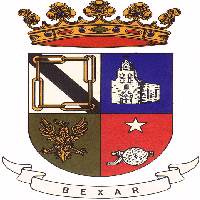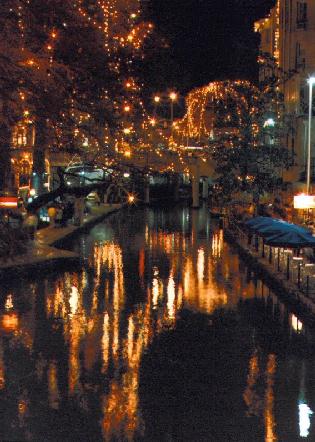![]()
San Antonio, Texas, is the eighth largest city in the USA,
but it is not a stereotypical big city. Crime, although present, is not as
serious an issue as in most large metropolitan areas. There is a strong feeling
of heritage and a very rich culture here, the result of an interesting, colorful
history and a certain mystique just beyond the realm of words. The city is
built over an enormous, multi-chambered cavernous lake, referred to as the
Edwards Aquifer, and I theorize that its presence beneath us plays a significant
role in the quality of our lives here. In early days, another name for San
Antonio was San Fernando de Bejar, but colonist from the United States, mistaking
the Spanish "j" for an "x", corrupted Bejar into Bexar (pronounced "bear"). We are located in
the center of Bexar County, a roughly pentagonal hub to all the surrounding
county layouts. Bexar resides on the border of Texas Hill Country and the
thorn brush territory of the Gulf Coastal Plain, seated within a geographic
depression resembling a large, flat bottomed bowl, 701 feet above sea level
at its lowest point. This geography serves to shield the city from the majority
of severe weather occurrences which pass through the immediate region, but
it also shields us from much of the general precipitation that the hill country
enjoys. At 140 miles inland from the Gulf of Mexico, hurricanes are not a
great threat. Home to the NBA world champions of 1999, 2003, 2005 and 2007 the San Antonio
Spurs, the city covers 430 square miles with a population of 1,192,300 according
to 2000 Census. We rank towards the bottom of cost-of-living indexes, there
is no state income tax, and the local tax rate sits at 7.875%.
Originally called Yanaguana by the Papaya Indians, meaning "clear water,"
or "refreshing waters," the San Antonio River was "discovered"
by Spanish explorers and missionaries on June 13, 1691, and was named for
the Feast Day of Saint Anthony. The first Spanish Garrison was established
in 1718, when Father Antonio Olivares founded the Mission San Antonio de Valero.
This became a way station between missions in East Texas and Mexico. In early
1803, La Segunda Compa–’a Volante de San Carlos de Parras (Alamo de Parras),
a company of one hundred Spanish Colonial mounted lancers, arrived in Texas
to bolster the existing San Antonio garrison. During the following 32 years,
they settled and integrated into the community, eventually serving roles in
both the Mexican War for Independence and the Texas Revolution. Their legacy
was to give their name to the mission San Antonio de Valero, and it is through
their association that it came to be known as the Alamo.
As time passed and American immigration increased, resentment of Mexico's
rule of the region turned to defiance. On Tuesday, February 23, 1836, the
president & dictator of Mexico, Santa Anna, led aprox. 4000 troops in
a 13
day siege of the Alamo, going up against a mixed band of 189 defenders.
Although these heroes were greatly outnumbered, they inflicted heavy casualties
upon Santa Anna's army before finally being defeated on March 6th. Santa Anna
was, in turn, routed by Sam Houston's Texan Army at The Battle of San Jacinto
on April 21, 1836. This is where the world famous rallying cry of the Texas
Revolution "Remember the Alamo!" was born. The Texas Revolution
resulted in San Antonio coming under the rule of the newly formed Republic
of Texas, and was Incorporated in 1837. The young Republic of Texas was later
annexed to the United States in 1845.
Indians have inhabited this region of Texas for thousands of years. In fact,
the state's name was derived from the Caddoan Indian word for "friend",
but Americans mistook the Spanish "j" for an "x" and corrupted Tejas into
Texas. Artifacts indicative of migratory encampments were recently uncovered
on the deep southside of town near what would become the site of a multi-million dollar
Toyota manufacturing plant.
Many cultures have long believed that spirit forces, or guardians, exist around
and within bodies of water. Regardless of opinions concerning this idea, there
is a particular feeling which accompanies bodies of water, possibly
attributable to electromagnetic field variations, or perhaps, ionization effects.
Consider the subtle influences of a huge multi-chambered lake beneath a city.
I theorize that our aquifer lends a sense of tranquility to San Antonio, a
force which continues to comfort us with its calming effect. Our water is
also noted as being some of the best in the country, due to natural limestone
filtering. This does result in very hard water, though, but that is good because
science has shown that life expectancy is longer for those who consume hard
water minerals. On a negative note, however, we recently became victim to
a local(?) campaign which actively misled voters into fluoridating our water,
despite 2 previous votes against it. San Antonio had been
the last big city hold-out in the US, but we are now a part of the forced-docility
fluoride poisoning plan
which most every other nation has banned due to increased scientific knowledge.
(After researching the truth and lies about fluoride, I actively campaigned
against it, with very good reason.)
As in any locale, there are some negatives. For instance the scenic hill country which borders us not only
provides a beautiful, quick getaway, but it fills our air with cedar pollen during
the late summer through fall and into the winter months. It is very hot during the summer months, along
with perpetual high humidity during much of the year. We are considered to
have a modified subtropical climate. Our rains are much too infrequent for
my liking, and we often seem to be in a continuous semi-state of drought. Fires from
Mexico field burning create a transitory haze of smoke during April and May,
and heavy pollution from the Tennessee Valley too often pollutes our air during
summer months. These uncontrollable factors have resulted in threats of EPA
economic sanctions, regional ozone health alerts, and even occasional traces
of marijuana in drug tests (field burning.) Despite these things, San Antonio
is an appealing, enchanting locale, especially for a Big city.
MAP
San
Antonio Missions
San Antonio Riverwalk
San Antonio, Texas Guide
San
Antonio Lightning Newspaper

